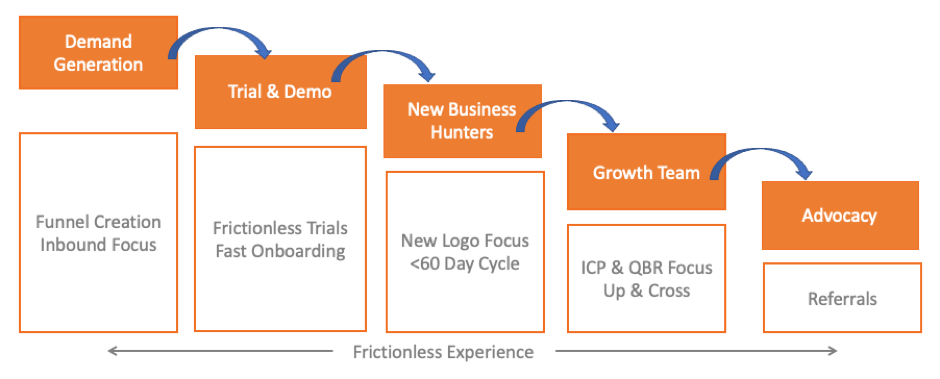CEO Blog - Advice for CEOs on growth and scaling
The SaaS Marketing Playbook, Part 4 | Getting Sales and Marketing on the Same Page

Of the things that are aligned in our life — the stars, automobiles, our spine, and the universe — there’s one area where such alignment is elusive – and, by extension, costly. If you have ever tried to align your sales and marketing departments, you likely already have experienced how vexing this can be.
In my experience, sales and marketing alignment will never be easy. Why not? Three immediate reasons come to mind: 1) Marketing is from Mars and Sales is from Venus, 2) The question of pipeline ownership, and 3) The targets for sales never get lower, and they need to take it out on someone.
But, I’m here to tell you that this is one shotgun wedding you’ll want to force. Some reasons why: Companies with aligned sales and marketing teams are 67 percent more efficient at closing deals and reap 209 percent more revenue than if working apart. Also, aligned departments can achieve nearly 40 percent higher sales win rates.
If you’ve been with me since the beginning of this blog series, you understand how much is at stake. We’ve worked together to sharpen the brand, to focus the demand generation program, and to implement some better ways to analyze our data. But none of this will mean a hill of beans without your sales and marketing players executing from the same playbook.
Because sales and marketing alignment is both natural and unnatural, it’s important to design a model and culture which emphasizes the former over the latter. In this blog we will lay out the B2B SaaS organization model and the four essentials I recommend that will support productive collaboration and consistent, scalable pipeline creation.
The GTM Organization
Let’s start at the top, rather than the bottom: What should your unified go-to-market organizational model look like? In my experience, I favor one that facilitates product-led-growth, like a product flywheel. Regardless of the model you choose, you’ll need to make sure that your sales and marketing leaders complement each other, both technically, and personally. As a marketing leader there is nothing more rewarding than knowing a sales leader has your back.

A recent trend is the hiring of a chief revenue officer, or CRO, who can own sales, marketing, and customer success. Does this work? It can. As always, it depends on the leaders. Your CRO will always be stronger in either sales or marketing, so their lieutenants will need to bring skills that are complementary. There are benefits to this approach, as there is less friction throughout the organization.
The 4 Essentials of Collaboration
1. ReportingMarketing ops, sales ops, or revenue ops? Whichever approach you choose, all key players must agree to the same data model that tracks lead source, lead attribution, and lead routing. Getting your ops team aligned with sales and marketing management for this essential task reduces finger pointing. When it comes to reporting, there’s nothing quite as wasteful as constant bickering about who is generating what leads, or that one team is not doing their job. Instead, focus on where the gaps are, and how both teams can solve the problem.
2. Sales Enablement
Get this right, and you’ll invariably see your win rate increase. But for many, sales enablement is a nebulous concept. Simply put, sales enablement refers to the tools and training used to ensure that sales is efficient and effective in their prospecting, deal progression, and deal closing. Sales enablement relates both to your company positioning and your generic sales best practices. I approach sales enablement by deploying a common positioning framework for both product positioning and the sales process. Then, I give product marketing the task of managing the tools (product presentations, datasheets, case studies, and battle cards) and give sales the job of training and roleplaying around product adoption.

My favorite tip is to roleplay by “pedestal.” Every week, I take 30-minutes with each sales team and pedestal a rep at random. Then, we spend 10-minutes as a team to listen to one of their calls from the previous week, and then 20 minutes for the team critique. Practice radical candor, but stay constructive.
3. MOFU — Or, Where Do the BDRs Go?MOFU, or middle of the funnel, is the trickiest operational problem to solve in sales and marketing. Get this right and you optimize lead-to-opportunity conversion. For example, if your annual sales volume is lower, you’ll need more inbound support from marketing; higher volumes indicate more outbound and field sales support. If the organization is launching a significant effort in inbound, your business development representatives (BDRs) can start in marketing and then transition to sales when the machine is working. It’s very valuable for BDRs to live in marketing at some point, so marketing can gain a feel for creating the pipeline and truly understand what represents a good lead. This understanding brings greater alignment with sales.
4. BudgetsI like to split my budget evenly between in-house personnel, and agency/contractors for marketing, and then I like to again split about 50/50 between personnel spend and program spend. There is no point in having people if they don’t have budget to spend on programs for demand gen. However you organize your budget, make sure you give sales a voice in how that program budget is spent, using the sales velocity info from your data model and reporting. If sales has veto power and can influence spend in certain areas, both teams will build trust and a better understanding.
Finally, the answer to the question about who creates pipeline: It’s BOTH sales and marketing! My experience is that marketing creates just over 50 percent of pipeline (this equates to about 70 percent for acquisition and 40 percent for expansion). In fact, sales campaigns and floor days are extremely effective tactics for growing pipeline, especially when you’re in the process of establishing your demand gen engine.
Pipeline contribution between sales and marketing does vary based on your product, market, and sales velocity. For the Mars and Venus questions and considering culture, sales naturally thinks in terms of transactions, while marketing thinks about campaigns. Sales, because of their role, operates in shorter-timeframes and experiences more extreme emotional ups and downs. This understanding is important to support collaboration. When was the last time someone in marketing got on the phone and did some cold calling? Maybe start there.
What’s Next?
I hope this blog series has been helpful to you in gaining a better understanding about the contemporary sales playbook. If you would like assistance in developing your own playbook, give me a call. I’d be happy to help.
In case you missed the first three blogs in the series:
Topics: Marketing Metrics, Marketing Plan for SaaS, SaaS Strategy
Wed, Jun 2, 2021Related Articles

- Press Releases
- Careers
- Case Studies
- Marketing Consultant Company
- Marketing Strategy Consultants
- Marketing Plan Consultants
- B2B Marketing Consultants
- Virtual CMO
- Marketing Consultant Outsourcing
- Fractional CMO
- What is a Fractional CMO
- Healthcare Marketing Consultant
- Marketing Consultant Houston TX Texas
- Marketing Consultant Texas TX
- Marketing Consultant Bay Area
- CEO Blog
- Ebooks Plus
- Executive Marketing Consultants
- Product Marketing Consultants
- B2C Marketing Consultants
- Virtual Marketing Consultants
- Senior Marketing Consultants
- Temporary CMO
- Hire a CMO
- Fractional CMO Salary
- Fractional CMO Responsibilities
- Marketing Consultant Austin TX Texas
- Marketing Consultant Dallas TX Texas
- Marketing Consultant San Antonio
- Helping Private Equity
- Private Equity Blog
- Leadership Team
- Privacy Policy
- Business Marketing Consultants
- Strategic Marketing Consultants
- Marketing Technology Consultants
- Sales and Marketing Consultants
- CMO Job Description
- CMO Salary
- Fractional CMO Agency
- Fractional CMO Services
- CPG Marketing Consultant
- Marketing Consultant San Diego
- Partners
Houston, TX 77056
© 2023 Chief Outsiders


